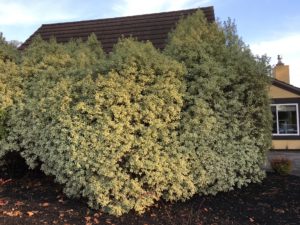Details Landscape Art is a landscape contractor. Our services include the design and installation of fine gardens. We do not offer regular garden maintenance services, such as cutting grass, weeding and leaf pickup. We do, however, offer a once a year winter pruning service to our installation clients.
This pruning service benefits the client greatly, since we know how and when to take care of the plant material we instal. It also benefits us, the contractor. We frequently bring prospective new clients to prior projects to see our work. We love to show off the design and installation of fine gardens we have done. The winter pruning allows us to ensure that these jobs look their best.
The appropriate time of year for pruning most plants is November through January, when deciduous trees and plants have dropped their leaves and are in their dormancy. They say that when tree sap is running, pruning can damage the tree. So when it’s not actively growing, the sap stops running and we can safely prune. It’s also much easier to see the branching structure when the leaves are not blocking our view of the branches.Pruning trees is a process of removing dead branches, crossing branches, thinning to allow airflow through the tree, and pruning to shape as needed or required by the homeowner.
Pruning shrubs or ornamentals is similar. We would never shear a plant into ‘green meatballs’ so to speak…we prefer to see plants retain their natural habit. Evergreen shrubs get pruned ‘to shape’ We lightly cut scraggly or dead branches, shoots that may be laying on the ground, or lightly thin a congested interior..Some upright screening shrubs do benefit from occasional vertical shearing, however, to retain their fullness.
Some grasses and certain deciduous perennials require cutting to the ground – they will emerge again in the spring. There are other plants such as salvia leucantha (Mexican sage) need to be left alone until the danger of frost has passed. Pruning encourages new growth from the base, and this new growth (which is actually next year’s plant) is tender. A hard frost will surely damage the new tender shoots, so we leave the older scraggly growth on the plant to protect the new baby growth until mid March, at which time the dead growth is removed, the plant fertilized, and the plant takes off again.
Part of our winter pruning service may be covering potentially frost tender plants. Generally we refrain from installing plants that will freeze. However, there are a few plants that are marginally frost tender, such as Coleonema ‘Golden Sunset or purple lantana. Coleonema is frost tender only the first winter – thereafter it becomes more hardy. So we may cover them the first winter to protect them. Lantana may get frost bit, but usually bounces back. But we try to cover them anyway as a precaution.
Knowing which plants and trees to prune and when is critical, and Details Landscape Art certainly knows how. The design and installation of fine gardens is an art form.
